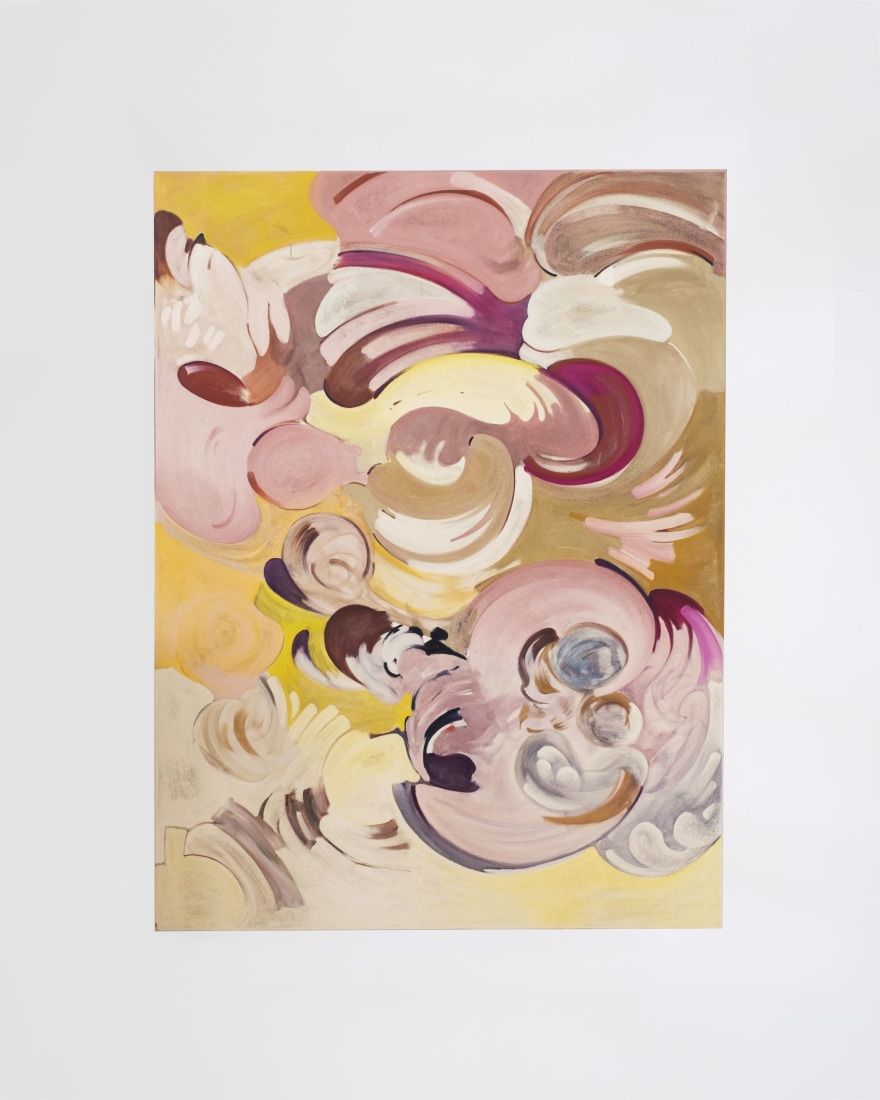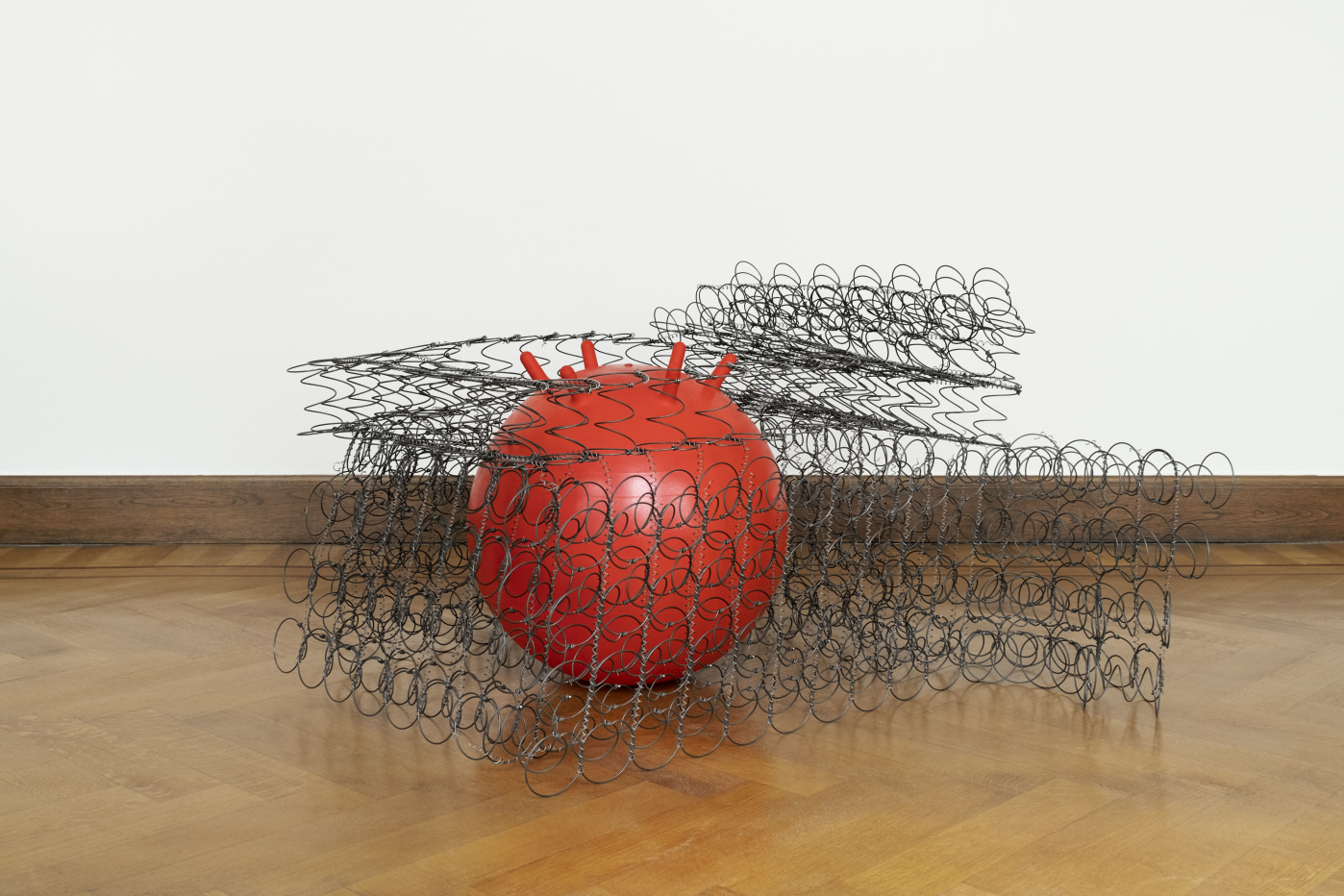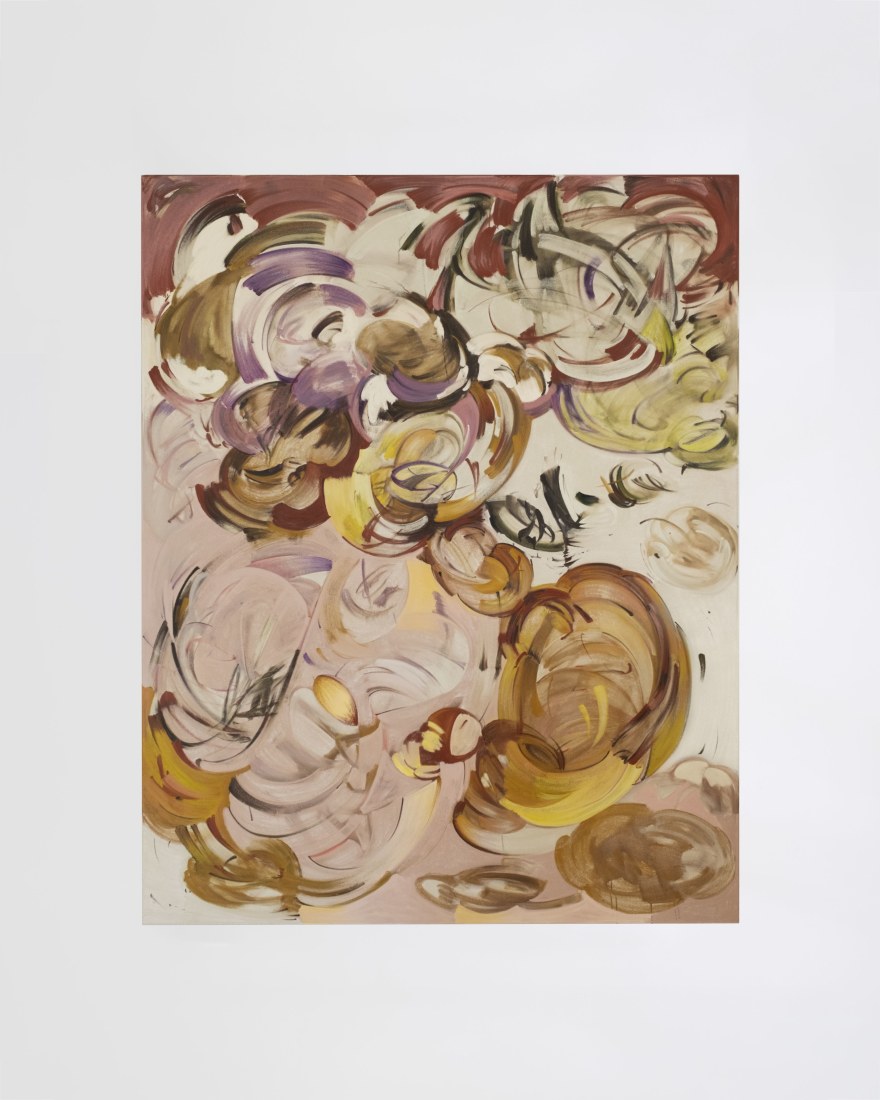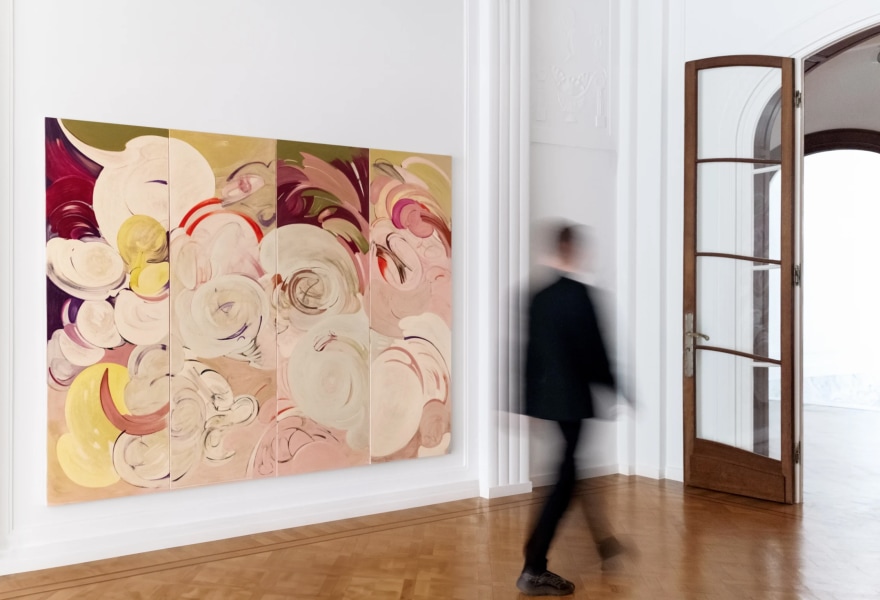01 september 2023, Yves Joris
The Colours of the Wind by Kaifan Wang
The contradiction is hard to overlook. At first glance, Kaifan Wang's work seems like a tornado of colours, yet also gives an almost meditative feeling of peace. The exhibition opened on 26 August at GNYP Gallery with the enigmatic title Is the spot on the neck bitten by mosquitoes? With this question in mind, I also asked the artist a few more mundane questions.
Due to our busy schedules, we decided to do the interview remotely. Living in the modern world has its advantages and disadvantages. In the photos sent to me by the gallery, I see a young man looking determinedly into the lens. In the background are a few works that, with their swirling colours, are at odds with the tranquillity transmitted by the artist himself.

Kaifan Wang, Whispers in soot II, 2023, GNYP Gallery
What inspired you to create the works for your first solo exhibition in Belgium?
Initially, I wanted to build on the concept I had developed during my last solo exhibition (2022) at GNYP Berlin, which was the relationship between the body and the environment. At the beginning of 2023, I was tested for different allergies since I’ve always suffered from rhinitis. My nasal inflammation worsened when I moved from China to Berlin. The test results showed that I had about a dozen allergies to plants and on my doctor's advice, I was given allergy shots. I was reminded of the work of Italian philosopher Roberto Esposito in which everything revolves around two concepts: community (communitas) and immunity (immunitas). This interplay – or constant interaction – inspired me to create this new series of works.
Some of the works are so recent that the paint may not be dry yet. Did your stay in Antwerp influence your paintings?
I had already made some paintings in Berlin and five works were created during my stay in Antwerp. I had a large studio here with high ceilings, which allowed me to create work that challenged my physical control. This forced me to think more about the entire composition from the very start. A firm brushwork provided control while at the same time allowing me to give it ‘room to breathe’. Yes, my environment has definitely influenced my work. In the summer, I have more daylight and can work until late at night. I enjoyed the evening sunsets in Antwerp, mostly watching the sunset from the balcony of my studio. The sky seems so close here that when you stand tall, it feels like you can touch the clouds, a bit like in my hometown in Inner Mongolia. I think that's why I couldn't resist using a lot of orange, yellow and red tones in my work.

Kaifan Wang, Is the spot on the neck bitten by mosquitoes?, GNYP Gallery
How did you address the challenge between body and canvas?
As I mentioned earlier, my canvas was bigger than ever, beyond my physical boundaries. This complexity was challenging. There were times when I had to jump to reach the top surface of the canvas, an act I found strangely exciting because of its unpredictability. At the same time, I had to keep my balance to avoid accidents without losing sight of the composition. This is how art emerged for me as a dynamic duel between sensitivity and rationality, a battle between my body and the canvas.
You also use unusual techniques in your work. Can you explain how using sponges and oil pastels has contributed to the creation of your abstract, wavy shapes?
A sponge is a naturally soft medium that requires speed to achieve sharp lines in drawings. Although it can be difficult to control in principle, it opens up a range of possibilities for any artwork. It is comparable to brush control in calligraphy.
The composition of oil pastels contrasts strongly with the sponge and requires a different approach. I usually use the oil pastel to evenly cover vast areas, similar to draping with a veil. In this way, I try to create a consistent spatial experience with these different forces.
In addition to sponges, I also read that you are quite interested in... mattresses?
races are formed by repetitive habits and abstract paintings can also be described as a combination of different influences. Take a mattress, for example. The dark-coloured part is the part the owner often lies on. Some people like to sleep on their side, others like to lie in the middle, still others like to curl up or stretch out. Repetition, habit and body sensitivity are central to my decision to express myself through painting, with ambiguity and ineffability forming the onset of abstraction. I hope to be able to express this experience on canvas with oil paint using similar materials.
How do these traces of human presence, both visible and invisible, manifest themselves in your work?
I already mentioned that mattresses capture markings and shades of colour that contain the traces of a person's life, not only visible shades, but also intangible elements such as scents and hidden stories. In my oil paintings, I also strive to capture these experiences. Layer by layer, my brushwork encapsulates the essence of these memories. Some shades, like cryptic messages, are buried in deep layers, evading immediate recognition. Some step forward with a hushed subtlety, just beyond our reach, while others dart forward with an emotional intensity that resonates deeply.

Kaifan Wang, Spot on the neck II, 2023, GNYP Gallery
This brings us to – let's be honest – the rather unusual title of your new exhibition. What should we make of Is the spot on the neck bitten by mosquitoes??
The title is inspired by the immunological marks left behind after mosquito bites or triggered by allergies. I often encounter people who use these anecdotes in conversation as hidden metaphors for intimate relationships. Inspired by this, I wanted to convey my personal encounters with a similar mix of ambiguity and playfulness, effectively bridging the gap between the seriousness of the subject and its relatability.
In my creative process, I often explore the idea that the inner world, our emotions, thoughts and experiences, are not isolated from the external environment. Rather, they are intertwined and influence each other. Colour and texture serve as tools to convey this dynamic. Delicate brushstrokes mingle with bold strokes, carefully echoing the nuances of inner emotions against the vast canvas of the outside world.
I also read somewhere that you are interested in medieval frescoes?
Yes, I am fascinated by faith, rituals and ancient cultures. My fascination with abstraction parallels the textured patina of frescoes, which carry a sense of deeper wisdom. As we witness frescoes peeling and undergoing the transformative effects of air oxidation, this fading enriches the essence of the image itself. I want to cover the image with several layers of colour, leaving the underlying colours faintly visible.
Wind also plays an important role in your work, right?
I don't actually depict the wind. It is merely a carrier. It's the things and messages it carries that I partially express. The wind does not appear in my images, even though it is omnipresent.
How do you view the relationship between the wind on the one hand and body and mind on the other?
I can best explain this from the point of view of Chinese logic. According to Chinese medicine, wind is often identified as the fundamental basis of ailments. Numerous illnesses are attributed to its influence, giving it a central role in health considerations. In its natural state, wind remains benign, but in cases where an individual's immunity is deficient, it transforms into malevolent forces known as ‘evil wind’. This malignancy can arise from external sources or manifest internally within the body.
Taoist philosophy often draws parallels between the human body and the natural world, resulting in principles such as Feng Shui. Here the body echoes the rhythms of nature. In my perception, wind forms an active force, while people adopt a more passive attitude, creating a complicated dance. My focus is on the investigation of human survival within this interplay or the search for a harmonious balance.

Kaifan Wang, Ah-choo knotted in the air II, 2023, GNYP Gallery
You grew up in Hohhot in China. How has this affected your work?
Hohhot is a hub where Chinese and Mongolian cultures converge. As a Han Chinese, I also wanted to immerse myself in Mongolian culture, but that is difficult. Just as I wanted to integrate into Berlin society, I also enjoyed being a spectator. Hohhot is a small town where everyone knows each other and there is a sense of belonging. It is also a border town that makes you dream of distant, unknown places. The dust storms with their yellow sand made me forget their destructive nature and instead I was captured by their magnificence. I long for contact with nature, but I grew up in the city, so when I go to the grasslands, I want to enjoy the feeling of horseback riding, which makes me feel bigger, but I have a fear of insects, so I always jump across the grass to reach concrete and admire it from a distance.
Finally, can you tell us a little more about your artistic journey, from the study of traditional Chinese painting to the discovery of contemporary art in Beijing?
I started painting at the age of six, purely out of interest. My parents sent me to the local art school to develop my skills and when I was a little older, I started learning Chinese painting and calligraphy. By that time, I had already discovered that I preferred to express myself with colours. Later on, in order to take the entrance exams for the Chinese academy, I had to switch from Chinese painting to sketching and still lifes.
I also wanted to study abroad, so I moved to Beijing a year before my entrance exams, where I was introduced to contemporary art. I found that there are actually a lot of different mediums I can use, and like my teacher said at the time, you have to find your own weapon. After high school, I went to Germany with the support of my family to prepare for the German art school exams. In Germany, there is a talent test in which you have to submit a portfolio, an interview and a written exam. I was not very familiar with this exam system and found a course where two supervisors helped me with it. They told me that you need to first relax and then give it your all. I remember being very confused. My first painting in Germany was of three cups growing on a tree. I was miserable and was certain that the university would not want me. But within ten months, I had painted a hundred paintings and prepared three portfolios. I think I gained self-confidence because I stopped caring about what I was painting and it became purely a form of expression.
